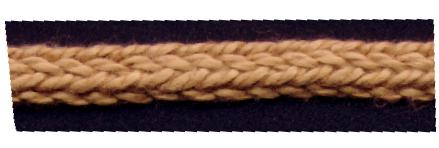 Here is a
broad lace of five loops (or "bows"). This one is worked in number 3 perle cotton.
Here is a
broad lace of five loops (or "bows"). This one is worked in number 3 perle cotton.

This document began as a set of samples I made for myself in 1997. Because of the recent publication of Noémi Speiser's comprehensive book on medieval and Renaissance pattern books for fingerlooped braids, and the even more recent publication of the SCA monograph "Fingerloop Braids" by Lois Swales and Zoe Kuhn Williams (The Compleat Anachronist, number 108), I was inspired to scan the samples for other people's use.
This document is provided as is without any express or implied warranties. While every effort has been taken to ensure the accuracy of the information contained, the author assumes no responsibility for errors or omissions, or for damages resulting from the use of the information contained herein.
Permission is granted to make and distribute verbatim copies of this document for non-commercial private research purposes provided the copyright notice and this permission notice are preserved on all copies.
© 1997-2000 Carolyn Priest-Dorman
This document began as a set of samples I began for myself in 1997 based on E.G. Stanley's edition of Harleian ms. 2320, article 4, "Directions for Making Many Sorts of Laces," dating to the early fifteenth century. Since then I've been keeping an annotated bibliography of sources on fingerlooping; a few of those sources are listed below. But there are not very many photographs of these braids (or "laces") out there, and fewer still are explicitly tied to the specific set of historical instructions for producing them. Accordingly, I have scanned these samples so they can serve as a sort of visual catalogue of the single-worker braids from Harleian 2320. The idea is for the reader to cross-reference these images with other existing works on fingerlooping. If you read this page without loading the graphics, you will find that each image is tagged with a short phrase describing the interlacement. These phrases are from Speiser's typology.
A number of two-worker braids are explained in the manuscript, but I have not finished that sample set yet!
The five-loop braid appears in four structural variants: broad, round, open, and thin. Bascon and endented braids are round five-loop braids with color effects. As Speiser notes, the "round" braid is in fact trapezoidal in cross-section, not round or square. However, it "reads" fairly square to the casual observer.
 Here is a
broad lace of five loops (or "bows"). This one is worked in number 3 perle cotton.
Here is a
broad lace of five loops (or "bows"). This one is worked in number 3 perle cotton.
 This is the
round lace of five loops. This one is worked in number 3 perle cotton.
This is the
round lace of five loops. This one is worked in number 3 perle cotton.
 This is the lace bascon, a trapezoidal lace with vertical ridges alternating in two
colors. This one is worked in number 3 perle cotton, rust (the upper ridge) and gold (the lower
one). Unfortunately the color contrast is not very great in this sample.
This is the lace bascon, a trapezoidal lace with vertical ridges alternating in two
colors. This one is worked in number 3 perle cotton, rust (the upper ridge) and gold (the lower
one). Unfortunately the color contrast is not very great in this sample.
 This is the lace endented, another trapezoidal lace with color effect:
little alternating chevrons. This too is worked in number 3 perle cotton (hey, I was on a roll!).
This is the lace endented, another trapezoidal lace with color effect:
little alternating chevrons. This too is worked in number 3 perle cotton (hey, I was on a roll!).
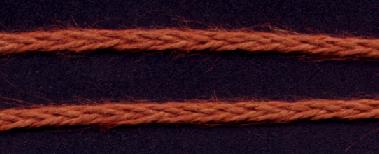 This is the
open lace of five loops, which is remarkable because it creates two completely
separate five-strand braids! This could have been the method of production for the tiny five-
strand braids on some of the St. Cuthbert relics (10th century England). If you use departed bows
with the same color up on all bows, the two braids will be different colors. This sample is
worked in 16/2 ramie.
This is the
open lace of five loops, which is remarkable because it creates two completely
separate five-strand braids! This could have been the method of production for the tiny five-
strand braids on some of the St. Cuthbert relics (10th century England). If you use departed bows
with the same color up on all bows, the two braids will be different colors. This sample is
worked in 16/2 ramie.
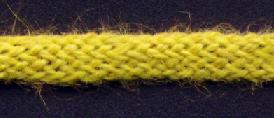 This is the
thin lace of five loops, a flat mostly-tabby lace. This one is worked in 6/2
unmercerized cotton.
This is the
thin lace of five loops, a flat mostly-tabby lace. This one is worked in 6/2
unmercerized cotton.
The seven-loop braid appears in four structural variants: hollow, broad, round, and open. It is initially trickier to work than the five-loop braid, because some fingers have to hold more than one loop at a time. But you get used to it pretty quickly. Most of these braids involve the same sequence of movements; the differences lie in whether a particular loop is taken reversed or unreversed.
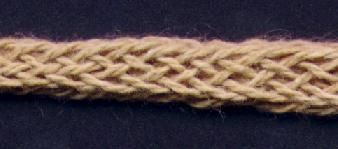 This is the
hollow lace of seven loops. An error in the transcription causes this braid to work
up flat; you have to take the C loop reversed on both sides, not on just the one side the
manuscript specifies. If you do you get a lace that is hollow, and trapezoidal in cross section.
This sample is worked in 6/2 unmercerized cotton.
This is the
hollow lace of seven loops. An error in the transcription causes this braid to work
up flat; you have to take the C loop reversed on both sides, not on just the one side the
manuscript specifies. If you do you get a lace that is hollow, and trapezoidal in cross section.
This sample is worked in 6/2 unmercerized cotton.
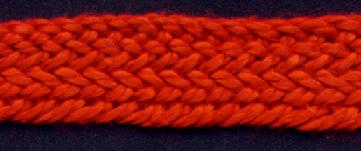 This is the
broad lace of seven loops, a flat lace with a tendency to curl inward. This sample is
worked in number 3 perle cotton.
This is the
broad lace of seven loops, a flat lace with a tendency to curl inward. This sample is
worked in number 3 perle cotton.
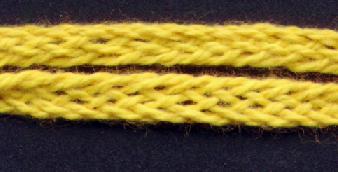 This is the
open lace of seven loops. Like the open lace of five loops, it creates two
simultaneous narrow braids, in this case with seven strands apiece. Also like the open lace of
five loops, if you use departed bows you get narrow laces of two separate colors. This sample is
worked in 6/2 mercerized cotton.
This is the
open lace of seven loops. Like the open lace of five loops, it creates two
simultaneous narrow braids, in this case with seven strands apiece. Also like the open lace of
five loops, if you use departed bows you get narrow laces of two separate colors. This sample is
worked in 6/2 mercerized cotton.
These two braids are worked with the same sequence of movements as regular seven-loop braids, but they add the element of twisting at a certain point in the sequence. They also use departed loops for color effect. They do not work up as fast, but they make up for it by being very attractive.
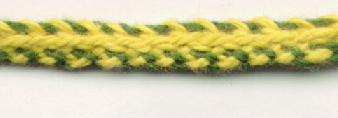 This is the
lace round party, a thick flat lace that corkscrews attractively. The color effect is
reversed on the other side. This sample is worked in 6/2 mercerized cotton.
This is the
lace round party, a thick flat lace that corkscrews attractively. The color effect is
reversed on the other side. This sample is worked in 6/2 mercerized cotton.
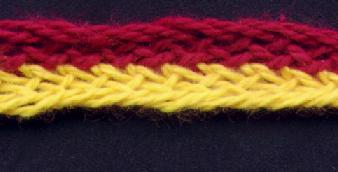 This is the
broad lace party. As you work it it looks like a thick two-layer lace with two
differently colored sides. After you work it you can open it up along the color boundary to make
it flat. This sample is worked in 6/2 mercerized cotton.
This is the
broad lace party. As you work it it looks like a thick two-layer lace with two
differently colored sides. After you work it you can open it up along the color boundary to make
it flat. This sample is worked in 6/2 mercerized cotton.
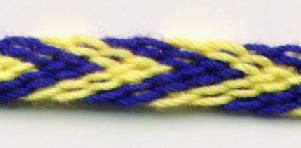 This is the broad lace chevron of eight loops, a flat lace. It has definite right and
wrong sides: although both sides have chevron patterning, the right side has much better color
boundaries than the wrong side. This sample is worked in crochet cotton.
This is the broad lace chevron of eight loops, a flat lace. It has definite right and
wrong sides: although both sides have chevron patterning, the right side has much better color
boundaries than the wrong side. This sample is worked in crochet cotton.
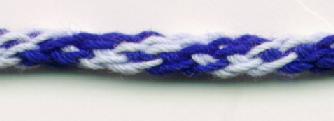 This is the round chevron of eight loops, which is really more oval than round in
cross-section. From some directions it looks patterned with chevrons, from others it simply
looks striped. This sample is worked in crochet cotton.
This is the round chevron of eight loops, which is really more oval than round in
cross-section. From some directions it looks patterned with chevrons, from others it simply
looks striped. This sample is worked in crochet cotton.
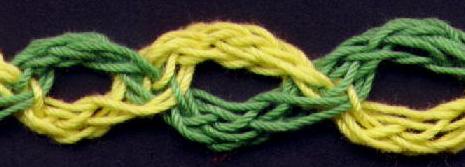 This is the lace
maskel, a pair of four-loop braids that intersect at regular intervals. There is an error in
the instructions with regard to set-up, but the instructions for working make it clear that eight
loops are required. This sample is worked in crochet cotton.
This is the lace
maskel, a pair of four-loop braids that intersect at regular intervals. There is an error in
the instructions with regard to set-up, but the instructions for working make it clear that eight
loops are required. This sample is worked in crochet cotton.
 This is the lace bend round of eight loops. It looks just like a plied cord, but it's
structurally very different and much more stable. This sample is worked in crochet cotton.
This is the lace bend round of eight loops. It looks just like a plied cord, but it's
structurally very different and much more stable. This sample is worked in crochet cotton.
 This is the lace cheyne broad, which despite its name is a round
lace that does sort of look like a couple of interlaced chains. This sample is worked in crochet
cotton.
This is the lace cheyne broad, which despite its name is a round
lace that does sort of look like a couple of interlaced chains. This sample is worked in crochet
cotton.
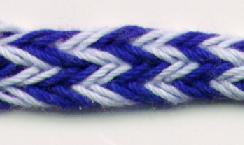 This is the
lace dawns, a puffy flat lace that tends to collapse into a groove at the middle. It's
really beautiful, but I thought it was hard to work. This sample is worked in crochet cotton.
This is the
lace dawns, a puffy flat lace that tends to collapse into a groove at the middle. It's
really beautiful, but I thought it was hard to work. This sample is worked in crochet cotton.
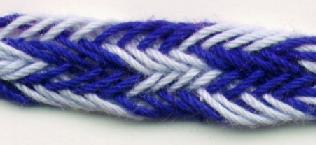 This is the
lace piol. It works the same as the lace dawns but with different color effect. This
sample is worked in crochet cotton.
This is the
lace piol. It works the same as the lace dawns but with different color effect. This
sample is worked in crochet cotton.
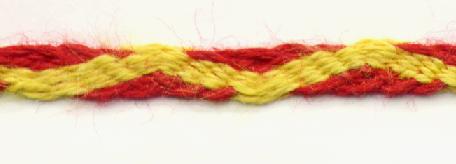 This is
the other lace endented, which looks nothing like the lace endented of five loops.
It's flat, and the pattern is a zig-zag stripe. There are some ambiguities in the instructions for this
lace, so the structure may differ as people interpret the instructions. But as nearly as I can tell,
the color arrangement would be the same no matter how one resolved the textual ambiguities.
This sample is worked in 16/2 ramie.
This is
the other lace endented, which looks nothing like the lace endented of five loops.
It's flat, and the pattern is a zig-zag stripe. There are some ambiguities in the instructions for this
lace, so the structure may differ as people interpret the instructions. But as nearly as I can tell,
the color arrangement would be the same no matter how one resolved the textual ambiguities.
This sample is worked in 16/2 ramie.
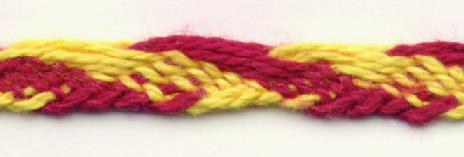 This
is the lace bend broad of eight loops, worked like the lace endented except that only
one hand does the looping. I found this easier to do than the lace endented, because I didn't
always have to remember (on a complex two-color warp) which direction I was going. This
sample is worked in 6/2 mercerized cotton.
This
is the lace bend broad of eight loops, worked like the lace endented except that only
one hand does the looping. I found this easier to do than the lace endented, because I didn't
always have to remember (on a complex two-color warp) which direction I was going. This
sample is worked in 6/2 mercerized cotton.
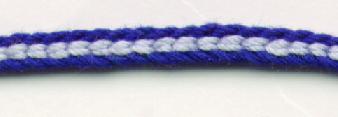 This is
the grene dorge, or grain d'orge (barleycorn). It is a flat, thick lace. An ambiguity
in the instructions makes it unclear whether two or three colors are supposed to be used. I read
it as two colors and this was the result, which does look like barleycorns. Speiser does it this
way too; Swales and Williams use three colors. This sample is worked in crochet cotton.
This is
the grene dorge, or grain d'orge (barleycorn). It is a flat, thick lace. An ambiguity
in the instructions makes it unclear whether two or three colors are supposed to be used. I read
it as two colors and this was the result, which does look like barleycorns. Speiser does it this
way too; Swales and Williams use three colors. This sample is worked in crochet cotton.
Crowfoot, Elisabeth; Pritchard, Frances; and Staniland, Kay. Textiles and Clothing c. 1150 - c. 1450. Medieval Finds from Excavations in London, 4. London: HMSO, 1992.
The section on "Fingerloop braids" (pp. 138-141) includes photos of three examples (there are a total of six examples illustrated throughout the book), line drawings for making a five-loop braid, and a table of the finds. The line drawings do not match the description in Harleian 2320.
Kinoshita, Masako. "The Traditional Silk Braids of Japan." Piecework III, no. 1 (January/February 1995), pp. 30-38.
Compares Japanese "kute-uchi"(hand-held) braiding technique with Western-style fingerlooping. In kute-uchi the loops are held on the whole hand rather than on individual fingers; however, the topology ("track plan") is identical to fingerlooped braids. The author worked with Noémi Speiser and translated historical Japanese manuals to learn these techniques.
-----. "Japanese Silk Braids to Make." Piecework III, no. 1 (January/February 1995), pp. 39-41.
Practical instructions for kute-uchi.
Singman, Jeffrey L., and McLean, Will. Daily Life in Chaucer's England. Westport, Conn.: The Greenwood Press, 1995.
The section "Making a Medieval Lace," pp. 132-135, includes an excerpt from a 15th century manuscript on the subject (Harleian 2320, article 4). The excerpt includes descriptions of the techniques for making three types of braids. The explanation on page 134 and McLean's drawing of hands working a five-loop braid (p. 134) do not conform to the description in the text of how to make a five-loop braid; neither does the authors' gloss on page 135 about how to set up the colored loops for a baston lace.
Speiser, Noémi. The Manual of Braiding. Basel: Published by the author, 1983.
A chapter on loop manipulation, with all subgroups of the method.
-----. Old English Pattern Books for Loop Braiding: A Monograph Critically Comparing English Instructions from the 15th and the 17th Century. Arboldswil, Switzerland: Published by the author, 2000.
Incorporates two 15th century and nine 17th century manuscripts, some materials of which overlap. The most thorough work on the topic, by any standard. Its abstract topological brilliance won't appeal to everybody, though.
-----. "Unusual Braids Produced by Loop Manipulation." The Weaver's Journal, Volume 10, Number 1 (Issue 37, Summer 1985), pp. 15-18, 67-73.
Builds on her work in The Manual of Braiding, including track plans. Although more directed toward unusual Peruvian braids, some good basic information on the simpler European types of braids is also included. Annotated bibliography, although she doesn't mention Harleian 2320.
Stanley, E.G. "Directions for Making Many Sorts of Laces," pp. 89-104 in Beryl Rowland, ed., Chaucer and Middle English Studies in Honor of Rossell Hope Robbins. London: George Allen & Unwin Ltd., 1974.
A modernized transcription of Harleian 2320, article 4, "Directions for making many Sorts of Laces...," tentatively dated to the early portion of the 15th century. A large number of braids are described; most are 5-loop, 7-loop, or 12-loop. Several braids require the assistance of a "fellow." Stanley is not fiber-savvy, and his introduction lacks a certain ease with the subject matter; he was drawn to the manuscript by its copious use of obscure heraldic words (e.g., "maskel," "compon," "endented," and "ounde") to describe different types of braids.
Swales, Lois, and Williams, Zoe Kuhn. "Fingerloop Braids." The Compleat Anachronist, 108 (July 2000). Milpitas, CA: The Society for Creative Anachronism.
Covers braids from Harleian 2320 as well as the 17th-century manuscripts V&A 86FF3, V&A T 313-1960, V&A 1-1012-1938 and 86FF4. Includes instructions, line drawings of braids, transcriptions of several recipes, tips for use in medieval costume, and an interesting original notation system.
This page was created on 9 July 2000 and last updated on 7 August 2000.
Back to Þóra's Textile Resources
No soliciting!capriest@cs.vassar.edu